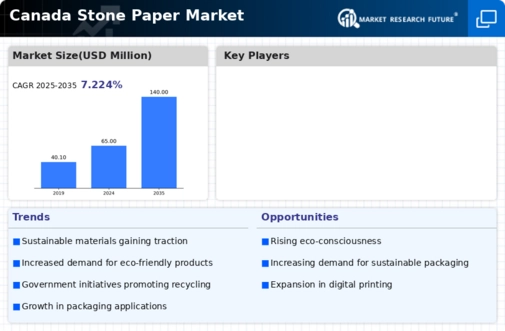Environmental Regulations
The stone paper market in Canada is experiencing a notable influence from stringent environmental regulations. As the government enforces policies aimed at reducing plastic waste and promoting sustainable materials, the demand for eco-friendly alternatives like stone paper is likely to increase. The Canadian government has set ambitious targets to reduce greenhouse gas emissions by 40-45% below 2005 levels by 2030. This regulatory framework encourages businesses to adopt sustainable practices, thereby driving the growth of the stone paper market. Companies that align with these regulations may find themselves at a competitive advantage, as consumers increasingly prefer products that are environmentally responsible. The stone paper market is thus positioned to benefit from these regulatory changes, potentially leading to a surge in market share for manufacturers who prioritize sustainability.
Consumer Awareness and Demand
In Canada, there is a growing consumer awareness regarding environmental issues, which is significantly impacting the stone paper market. As consumers become more informed about the detrimental effects of traditional paper production on forests and ecosystems, they are increasingly seeking sustainable alternatives. Surveys indicate that approximately 70% of Canadians express a preference for products made from recycled or sustainable materials. This shift in consumer behavior is prompting businesses to explore stone paper as a viable option. The stone paper market is likely to see a rise in demand as companies respond to this consumer trend, potentially leading to increased sales and market penetration. Furthermore, as educational campaigns about the benefits of stone paper continue, the market may expand even further, attracting environmentally conscious consumers.
Innovation in Production Techniques
The stone paper market in Canada is benefiting from ongoing innovations in production techniques. Advances in technology are enabling manufacturers to produce stone paper more efficiently and at a lower cost. For instance, the introduction of new machinery and processes has the potential to reduce production waste by up to 30%, making stone paper a more economically viable option. This innovation not only enhances the sustainability of the stone paper market but also allows for competitive pricing against traditional paper products. As production techniques continue to evolve, the stone paper market may witness an increase in the variety of products available, catering to diverse consumer needs. This could lead to a broader acceptance of stone paper in various sectors, including packaging, stationery, and printing.
Corporate Sustainability Initiatives
Many Canadian companies are increasingly adopting corporate sustainability initiatives, which is positively influencing the stone paper market. As businesses strive to enhance their environmental credentials, they are seeking sustainable materials for their operations. Reports suggest that over 60% of Canadian corporations have implemented sustainability strategies, which often include the use of eco-friendly materials like stone paper. This trend is likely to drive demand within the stone paper market, as companies look to align their product offerings with their sustainability goals. Furthermore, partnerships between stone paper manufacturers and corporations can lead to innovative applications and increased market visibility, potentially expanding the reach of stone paper products across various industries.
Government Incentives for Sustainable Products
The Canadian government is actively promoting the use of sustainable products through various incentives, which is expected to bolster the stone paper market. Programs that provide financial support or tax breaks for companies utilizing eco-friendly materials are becoming more prevalent. For instance, initiatives aimed at reducing the carbon footprint of businesses may encourage the adoption of stone paper as a sustainable alternative. This support from the government could lead to increased investment in the stone paper market, as manufacturers seek to capitalize on these incentives. As a result, the market may experience growth in production capacity and innovation, ultimately benefiting consumers with a wider range of sustainable product options.











Leave a Comment